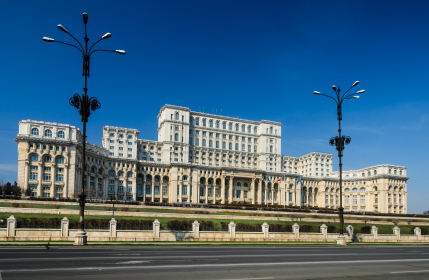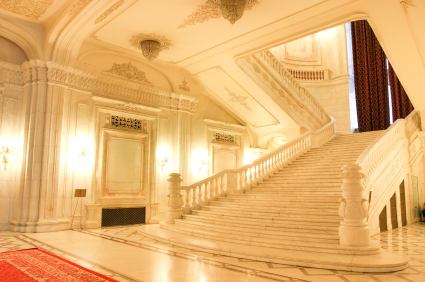The numbers are staggering and the history behind it makes your head spin.
According to Guinness World Records, the Palace of the Parliament in Bucharest is the heaviest building on the planet. It contains 700,000 tonnes of steel and bronze, a million square feet of marble, 3500 tonnes of crystal and 900,000 square metres of wood. It’s been described as a monstrosity, a beast and a horror.

How could such a building see the light of day?
The year was 1977. The earth shook under the feet of Bucharest’s inhabitants. Entire neighbourhoods were destroyed, resulting in 1500 deaths.
The communist dictator at the time, Nicolae Ceausescu, used the earthquake as a pretext to complete his vision of grandeur. Inspired by the colossal constructions of Pyongyang in North Korea, erected in glory of King-II Sung, the Romanian dictator decides to make Bucharest a futuristic city.
Ceausescu wanted to combine all of Romania’s political institutions under the same roof. He ordered an army of bulldozers to raze almost one-fifth of Bucharest’s historical neighbourhoods (about five square kilometres), wiping off the map forever between 7000 and 9000 picturesque homes and almost thirty very old churches.
The dictator pushed 40,000 Rumanians to new buildings, some of which were unsanitary and had no water or electricity. The construction of the palace provoked a collective trauma, as highlighted by author Diane Chesnais: “The collective memory still remembers his massive demolitions and the sacrifices made for his edification.”
Construction began in 1984. For five years, 20,000 workers laboured day and night, often in dangerous conditions, under the direction of some 600 architects and engineers. Ceausescu found a name for the building: the Palace of the People.

Each year, the work consumed up to 40% of the Romanian economy’s gross domestic product, bringing about the country’s ruin. According to Wikipedia, “marble quarries, and more specifically, rare pink marble, were depleted; entire villages contributed, by cutting crystal for example; monasteries and nuns were assigned to weaving long silk drapes with gold thread.”
The Michelin Guide gives the interior of the building a lively description: vast carpets, 1200 rooms the size of a football field and chandeliers like stars. According to The Rough Guide to Romania, a staircase was redone three times to please the Ceausescus. According to Lonely Planet, when the building was lit in the 80s, in four hours it consumed as much electricity as the city of Bucharest in a single day. The guide also states that it contains a bomb shelter 20 metres underground. Gallimard adds that the various underground levels reach 92 metres in depth, where people condemned to death dug secret passageways.
Communism fell in 1989. Thousands of angry Romanians pillaged and looted the palace. Ceausescu and his spouse were shot in the public square.
What to do with the palace? Since it wasn’t finished, there were thoughts of destroying it. Except that demolishing it would cost too much. Donald Trump wanted to make it the world’s largest casino, but the offer was turned down. Finally, the decision was made to house the Romanian House of Deputies, the Senate, museums and other institutions.
The building is so immense that whole rooms are still not used or maintained. And visitors only have access to 7% of the building.
References:
Guinness World Record, edition 2012, page 90
Roumanie, Michelin, collection Le guide vert, Paris, 2012, 462 pages
Romania, Lonely Planet, 2010, 364 pages
Roumanie, Guide Évasion, 2009, 303 pages
The Rough Guide to Romania, 2008, 519 pages
Roumanie, bibliothèque du voyageur Gallimard, 2008, 384 pages
Roumanie, Le petit futé, Paris, 2012-2013, 528 pages
Romania, National Geographic Traveler, 271 pages
Roumanie d’hommes et de lumières, Olivier Bourguet, éditions Vilo, 201, 221 pages
Voyage en Roumanie, Alain Kerjean, éditions Glénat, 2007, 158 pages
Wikipedia French article on the Place of the Parliament.